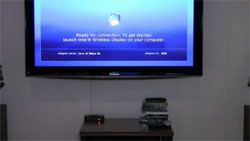Intel Wireless Display Screens-On: Connecting PC To TV Could Hardly Be Easier

One of our favorite new technologies of CES 2010 is Intel's Wireless Display (aka WiDi). Available on select notebooks with Intel's Core i3, i5 or i7 CPUs, the technology allows you to output the contents of your screen directly to your TV using the notebook's built-in 802.11n Wi-Fi card to transmit the signal. On the TV end, a set top box from NetGear called the NetGear Push2TV receives the signal and connects via HDMI to your home theater.
The concept of outputting PC to TV wirelessly exists in a few other forms, including wireless USB, wireless HDMI and WHDI (which we just saw demoed via the ASUS Eee WiCast Kit at CES). Intel's Wireless Display has the advantage of making the process of connecting PC to TV incredibly simple as notebooks equipped with it are able to output 720p video to TV with the touch of a simple button.
We had the opportunity to see WiDi in action at Intel's CES booth. The chipmaker had a special demo room set up, complete with a couch and a home theater with the Netgear Push2TV box attached to it. Sitting on the couch, we were able to output the screen from a Sony VAIO S Series, specifically a VPC-S111FM, directly to a flat panel TV that was about 10 to 20 feet away from us on the wall. All we had to do to was push the Wireless Display button that sits above the left side of the keyboard and wait less than 10 seconds for the connection to form.
The WiDi technology effectively treats the TV as a second monitor that can mirror, but cannot extend, the desktop. So, upon first connection, we saw our desktop, complete with all of our icons and Windows. We were then able to launch a browser and stream a 720p video trailer of Star Trek at full screen and the connection seemed, for the most part, smooth and audio was perfectly synced with the video.
However, as impressed as we were with WiDi, this new technology is not without its limitations, all of which leave room for improvement in the next generation. These include:
- 720p Limit: Video at 720p is smooth, but higher resolutions are not yet support so no 1080p.
- Limited Notebook Selection: Only a handful of notebooks, including the Sony we saw and the Toshiba E205, currently support the technology.
- Not Responsive Enough for High-Speed Gaming: We asked about gaming and Intel told us that there is too much of a delay between pressing the keyboard and action occurring on screen for gamers. They said the delay was less than a second, which is hardly noticeable for Web surfers and video watchers, but not fast enough to avoid being fragged. If you want to play something that doesn't require quick reflexes, like online scrabble, WiDi should be fine.
- No Support for Copy Protected Content: You can't play Blu-ray or other copyright protected content through WiDi.
Intel is actively working to resolve all of these issues for the next generation of WiDi. We're pleased with what we've seen so far and like the way this technology integrates seamlessly into the notebooks that have it. However, Intel faces stiff competiton from the likes of ASUS, whose Eee WiCast supports full 1080p streaming.
To see WiDi in action, check out our hands-on video below.
Stay in the know with Laptop Mag
Get our in-depth reviews, helpful tips, great deals, and the biggest news stories delivered to your inbox.
[flq:5f17ef485ba74b78a7858e47d6372102]
